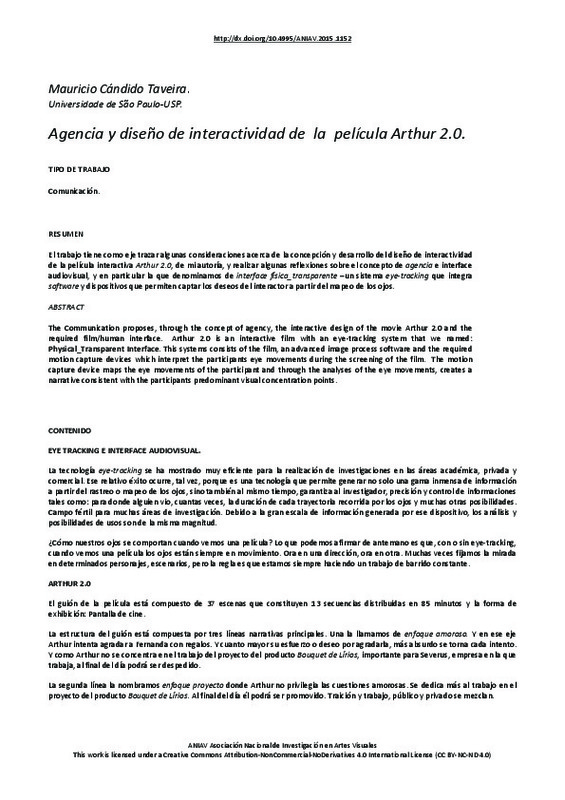JavaScript is disabled for your browser. Some features of this site may not work without it.
Buscar en RiuNet
Listar
Mi cuenta
Estadísticas
Ayuda RiuNet
Admin. UPV
AGENCIA Y DISEÑO DE LA INTERACTIVIDAD DE LA PELICULA ARTHUR 2.0
Mostrar el registro sencillo del ítem
Ficheros en el ítem
| dc.contributor.author | Taveira, Mauricio
|
es_ES |
| dc.date.accessioned | 2017-10-03T10:10:55Z | |
| dc.date.available | 2017-10-03T10:10:55Z | |
| dc.date.issued | 2015-11-26 | |
| dc.identifier.isbn | 9788490483411 | |
| dc.identifier.uri | http://hdl.handle.net/10251/88535 | |
| dc.description.abstract | [EN] The Communication proposes, through the concept of agency, the interactive design of the movie Arthur 2.0 and the required film/human interface. Arthur 2.0 is an interactive film with an eyeGtracking system that we named: Physical_Transparent Interface. This systems consists of the film, an advanced image process software and the required motion capture devices which interpret the participants eye movements during the screening of the film. The motion capture device maps the eye movements of the participant and through the analyses of the eye movements, creates a narrative consistent with the participants predominant visual concentration points. | es_ES |
| dc.description.abstract | [ES] Este trabajo tiene la intención de hacer algunas consideraciones sobre el concepto de agencia, tal como se emplea en las artes, y reflejar de la película Arthur 2.0. Arhur 2.0 es una película interactiva con el sistema de rastreo ocular que hemos denominado interfaz física#transparente. Esto incluye los softwares y los dispositivos que capturan los deseos del interactor de la asignación de los ojos. La estructura del guión se compone de tres historias principales. Una llamada enfoque amorosa en este eje narrativo Arthur intenta complacer a Fernanda, su novia con regalos. La segunda línea narrativa se llama enfoque proyecto A y Arthur centra su trabajo. Y en la última historia, llamado enfoque proyecto, dónde los dos ejes principales anteriores se mezclan. Se cuenta la historia desde el punto de vista de Arthur y muestra su jornada de trabajo y/o amorosa de sus recuerdos confusos. El interator a través del dispositivo de seguimiento ocular y su mirada, inconsciente, dirigida a un área específica del plano de la película, establece una narración toma de decisiones que pueden ayudar a Arthur a resolver sus problemas en uno de los seis momentos de la narración que conducen a 3 tres finales diferentes. | es_ES |
| dc.format.extent | 7 | es_ES |
| dc.language | Español | es_ES |
| dc.publisher | Editorial Universitat Politècnica de València | es_ES |
| dc.relation.ispartof | II CONGRESO INTERNACIONAL DE INVESTIGACIÓN EN ARTE VISUALES | es_ES |
| dc.rights | Reconocimiento - No comercial - Sin obra derivada (by-nc-nd) | es_ES |
| dc.subject | Arte | es_ES |
| dc.subject | Producción artística | es_ES |
| dc.subject | Estética | es_ES |
| dc.subject | Teoría del Arte | es_ES |
| dc.subject | Gestión cultural | es_ES |
| dc.subject | Educación artística | es_ES |
| dc.subject | Investigación artística | es_ES |
| dc.title | AGENCIA Y DISEÑO DE LA INTERACTIVIDAD DE LA PELICULA ARTHUR 2.0 | es_ES |
| dc.type | Capítulo de libro | es_ES |
| dc.type | Comunicación en congreso | es_ES |
| dc.identifier.doi | 10.4995/ANIAV2015.1152 | |
| dc.rights.accessRights | Abierto | es_ES |
| dc.description.bibliographicCitation | Taveira, M. (2015). AGENCIA Y DISEÑO DE LA INTERACTIVIDAD DE LA PELICULA ARTHUR 2.0. En II CONGRESO INTERNACIONAL DE INVESTIGACIÓN EN ARTE VISUALES. Editorial Universitat Politècnica de València. 138-144. https://doi.org/10.4995/ANIAV2015.1152 | es_ES |
| dc.description.accrualMethod | OCS | es_ES |
| dc.relation.conferencename | II Congreso Internacional de Investigación en Artes Visuales. |< real | virtual >| ANIAV2015 | es_ES |
| dc.relation.conferencedate | July 09-10,2015 | es_ES |
| dc.relation.conferenceplace | Valencia, Spain | es_ES |
| dc.relation.publisherversion | http://ocs.editorial.upv.es/index.php/ANIAV/ANIAV2015/paper/view/1152 | es_ES |
| dc.description.upvformatpinicio | 138 | es_ES |
| dc.description.upvformatpfin | 144 | es_ES |
| dc.type.version | info:eu-repo/semantics/publishedVersion | es_ES |
| dc.relation.pasarela | OCS\1152 | es_ES |








